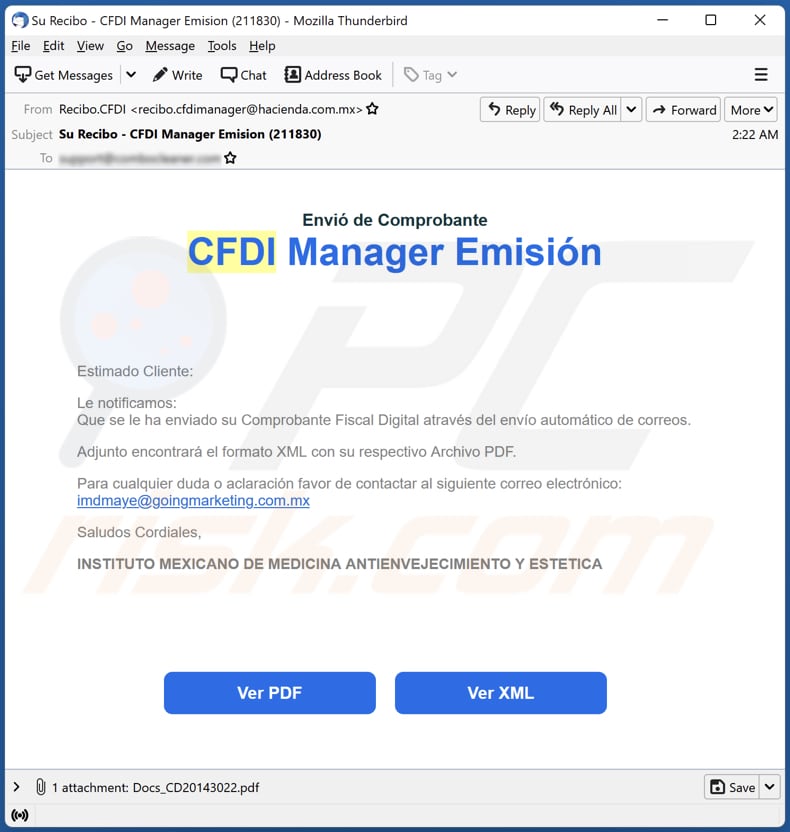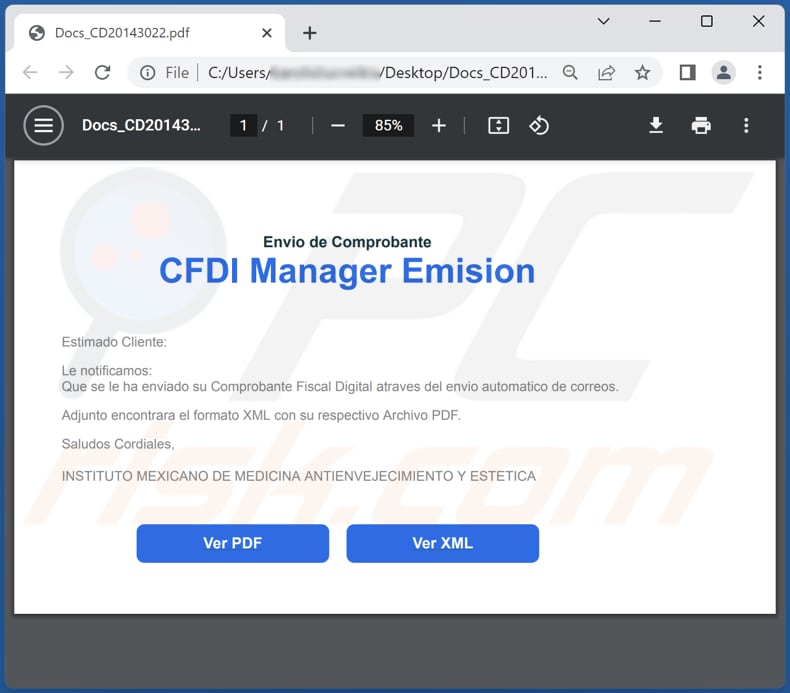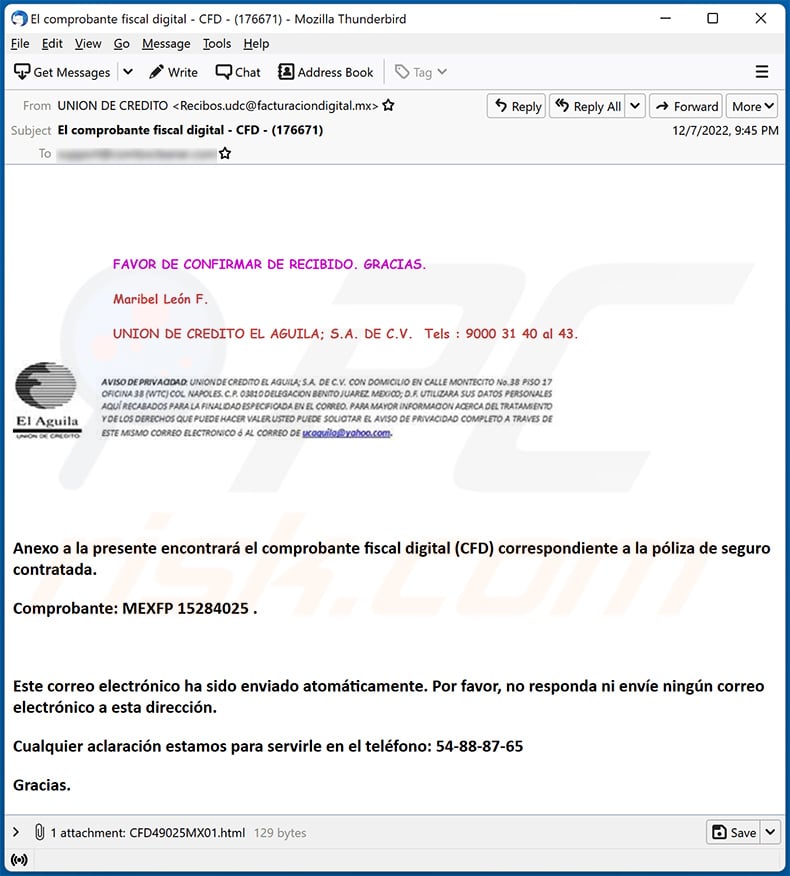How to spot scam emails like "CFDI Manager Emisión"
Phishing/ScamAlso Known As: CFDI Manager Emisión phishing email
Get free scan and check if your device is infected.
Remove it nowTo use full-featured product, you have to purchase a license for Combo Cleaner. Seven days free trial available. Combo Cleaner is owned and operated by RCS LT, the parent company of PCRisk.com.
What kind of email is "CFDI Manager Emisión"?
Our team has inspected this email and learned that it is a phishing email sent by scammers who aim to trick recipients into providing sensitive information. This scam email is disguised as a letter from the Mexican institute of anti-aging and aesthetic medicine. It contains two hyperlinks and an attachment leading to a phishing website.

More about the "CFDI Manager Emisión" scam email
This email is written in Spanish. It says that the file (a PDF document) attached to this email is a digital tax receipt. It also contains "Ver PDF" and "Ver XML" buttons (hyperlinks). Clicking those buttons or a link in the attached file opens a phishing website owned by scammers who aim to extract sensitive information from recipients.
During our investigation, the website promoted via this email was down. Typically, scammers use phishing websites (or emails) to steal credit card details, login information (e.g., usernames and passwords), ID card information, social security numbers, or other personal information.
Thus, this scam email should be marked as spam and deleted.
| Name | CFDI Manager Emisión Email Scam |
| Threat Type | Phishing, Scam, Social Engineering, Fraud |
| Fake Claim | Email contains a digital tax receipt |
| Disguise | Letter from the Mexican institute of anti-aging and aesthetic medicine |
| Symptoms | Unauthorized online purchases, changed online account passwords, identity theft, illegal access of the computer. |
| Distribution methods | Deceptive emails, rogue online pop-up ads, search engine poisoning techniques, misspelled domains. |
| Damage | Loss of sensitive private information, monetary loss, identity theft. |
| Malware Removal (Windows) |
To eliminate possible malware infections, scan your computer with legitimate antivirus software. Our security researchers recommend using Combo Cleaner. Download Combo CleanerTo use full-featured product, you have to purchase a license for Combo Cleaner. 7 days free trial available. Combo Cleaner is owned and operated by RCS LT, the parent company of PCRisk.com. |
Similar scam emails in general
Scammers behind phishing emails usually pretend to be legitimate companies, organizations, or other entities. They attempt to trick recipients into providing personal information directly via email or a phishing website. The most commonly targeted information is login credentials and credit card details.
Examples of different phishing emails are "Netflix - We've Suspended Your Membership", "New Sign-in With Your Mail Account", and "Storage Capacity". Crooks also use email to trick recipients into infecting their computers.
How do spam campaigns infect computers?
Recipients infect computers via email after opening malicious links or attachments (files). Typically, cybercriminals use malicious MS Office, PDF documents, executables, archives (like ZIP, RAR, and others), JavaScript files, or ISO files to distribute malware.
Different file types infect computers in different ways. For instance, Malicious MS Office documents infect computers after enabling macros commands (editing/content). Executables infect computers immediately after opening them.
How to avoid installation of malware?
Remember that irrelevant emails sent from unknown addresses (and other suspicious emails) often contain malicious files or links. Thus, double-check emails before opening attachments (or links). Also, download software from official pages and stores only. Avoid using other sources (e.g., P2P networks, third-party downloaders, shady pages, etc.).
Keep the operating system and installed programs updated. Do not use third-party tools to activate or update any software. Scan your computer for threats regularly. If you've already opened malicious attachments, we recommend running a scan with Combo Cleaner Antivirus for Windows to automatically eliminate infiltrated malware.
Text presented in the "CFDI Manager Emisión" email letter:
Subject: Su Recibo - CFDI Manager Emision (211830)
Envió de Comprobante
CFDI Manager Emisión
Estimado Cliente:
Le notificamos:
Que se le ha enviado su Comprobante Fiscal Digital através del envío automático de correos.Adjunto encontrará el formato XML con su respectivo Archivo PDF.
Para cualquier duda o aclaración favor de contactar al siguiente correo electrónico: imdmaye@goingmarketing.com.mx
Saludos Cordiales,
INSTITUTO MEXICANO DE MEDICINA ANTIENVEJECIMIENTO Y ESTETICA
Ver PDF
Ver XML
Screenshot of the attached PDF document containing links to a phishing page:

Another example of a spam email from this campaign:

Text presented within:
Subject: El comprobante fiscal digital - CFD - (176671)
FAVOR DE CONFIRMAR DE RECIBIDO. GRACIAS.Maribel León F.
UNION DE CREDITO EL AGUILA; S.A. DE C.V. Tels : 9000 31 40 al 43.
Anexo a la presente encontrará el comprobante fiscal digital (CFD) correspondiente a la póliza de seguro contratada.
Comprobante: MEXFP 15284025 .
Este correo electrónico ha sido enviado atomáticamente. Por favor, no responda ni envíe ningún correo electrónico a esta dirección.Cualquier aclaración estamos para servirle en el teléfono: 54-88-87-65
Gracias.
Instant automatic malware removal:
Manual threat removal might be a lengthy and complicated process that requires advanced IT skills. Combo Cleaner is a professional automatic malware removal tool that is recommended to get rid of malware. Download it by clicking the button below:
DOWNLOAD Combo CleanerBy downloading any software listed on this website you agree to our Privacy Policy and Terms of Use. To use full-featured product, you have to purchase a license for Combo Cleaner. 7 days free trial available. Combo Cleaner is owned and operated by RCS LT, the parent company of PCRisk.com.
Quick menu:
- What is CFDI Manager Emisión phishing email?
- Types of malicious emails.
- How to spot a malicious email?
- What to do if you fell for an email scam?
Types of malicious emails:
![]() Phishing Emails
Phishing Emails
Most commonly, cybercriminals use deceptive emails to trick Internet users into giving away their sensitive private information, for example, login information for various online services, email accounts, or online banking information.
Such attacks are called phishing. In a phishing attack, cybercriminals usually send an email message with some popular service logo (for example, Microsoft, DHL, Amazon, Netflix), create urgency (wrong shipping address, expired password, etc.), and place a link which they hope their potential victims will click on.
After clicking the link presented in such email message, victims are redirected to a fake website that looks identical or extremely similar to the original one. Victims are then asked to enter their password, credit card details, or some other information that gets stolen by cybercriminals.
![]() Emails with Malicious Attachments
Emails with Malicious Attachments
Another popular attack vector is email spam with malicious attachments that infect users' computers with malware. Malicious attachments usually carry trojans that are capable of stealing passwords, banking information, and other sensitive information.
In such attacks, cybercriminals' main goal is to trick their potential victims into opening an infected email attachment. To achieve this goal, email messages usually talk about recently received invoices, faxes, or voice messages.
If a potential victim falls for the lure and opens the attachment, their computers get infected, and cybercriminals can collect a lot of sensitive information.
While it's a more complicated method to steal personal information (spam filters and antivirus programs usually detect such attempts), if successful, cybercriminals can get a much wider array of data and can collect information for a long period of time.
![]() Sextortion Emails
Sextortion Emails
This is a type of phishing. In this case, users receive an email claiming that a cybercriminal could access the webcam of the potential victim and has a video recording of one's masturbation.
To get rid of the video, victims are asked to pay a ransom (usually using Bitcoin or another cryptocurrency). Nevertheless, all of these claims are false - users who receive such emails should ignore and delete them.
How to spot a malicious email?
While cyber criminals try to make their lure emails look trustworthy, here are some things that you should look for when trying to spot a phishing email:
- Check the sender's ("from") email address: Hover your mouse over the "from" address and check if it's legitimate. For example, if you received an email from Microsoft, be sure to check if the email address is @microsoft.com and not something suspicious like @m1crosoft.com, @microsfot.com, @account-security-noreply.com, etc.
- Check for generic greetings: If the greeting in the email is "Dear user", "Dear @youremail.com", "Dear valued customer", this should raise suspiciousness. Most commonly, companies call you by your name. Lack of this information could signal a phishing attempt.
- Check the links in the email: Hover your mouse over the link presented in the email, if the link that appears seems suspicious, don't click it. For example, if you received an email from Microsoft and the link in the email shows that it will go to firebasestorage.googleapis.com/v0... you shouldn't trust it. It's best not to click any links in the emails but to visit the company website that sent you the email in the first place.
- Don't blindly trust email attachments: Most commonly, legitimate companies will ask you to log in to their website and to view any documents there; if you received an email with an attachment, it's a good idea to scan it with an antivirus application. Infected email attachments are a common attack vector used by cybercriminals.
To minimise the risk of opening phishing and malicious emails we recommend using Combo Cleaner Antivirus for Windows.
Example of a spam email:

What to do if you fell for an email scam?
- If you clicked on a link in a phishing email and entered your password - be sure to change your password as soon as possible. Usually, cybercriminals collect stolen credentials and then sell them to other groups that use them for malicious purposes. If you change your password in a timely manner, there's a chance that criminals won't have enough time to do any damage.
- If you entered your credit card information - contact your bank as soon as possible and explain the situation. There's a good chance that you will need to cancel your compromised credit card and get a new one.
- If you see any signs of identity theft - you should immediately contact the Federal Trade Commission. This institution will collect information about your situation and create a personal recovery plan.
- If you opened a malicious attachment - your computer is probably infected, you should scan it with a reputable antivirus application. For this purpose, we recommend using Combo Cleaner Antivirus for Windows.
- Help other Internet users - report phishing emails to Anti-Phishing Working Group, FBI’s Internet Crime Complaint Center, National Fraud Information Center and U.S. Department of Justice.
Frequently Asked Questions (FAQ)
Why did I receive this email?
The same email was sent to all recipients. Crooks behind phishing emails usually do not target anyone specifically.
I have provided my personal information when tricked by this email, what should I do?
If you have provided login information (e.g., a username and password), change all passwords as soon as possible. If you have provided other personal information like credit card details, ID card information, social security number, etc., contact the corresponding authorities.
I have downloaded and opened a malicious file attached to an email, is my computer infected?
Executables infect computers after they are opened. However, other files usually do not infect computers until additional actions are taken (e.g., until macros commands in MS Office documents are enabled).
I have read the email but did not open the attachment, is my computer infected?
It is safe to open emails even when they include malicious files (attachments) or website links.
Will Combo Cleaner remove malware infections that were present in email attachment?
Yes, Combo Cleaner will run a system scan and remove malware. It can detect almost all known malware. It is important to mention that computers infected with high-end malware must be scanned using a full scan option. Typically, malware of this kind hides deep in the operating system.
Share:

Tomas Meskauskas
Expert security researcher, professional malware analyst
I am passionate about computer security and technology. I have an experience of over 10 years working in various companies related to computer technical issue solving and Internet security. I have been working as an author and editor for pcrisk.com since 2010. Follow me on Twitter and LinkedIn to stay informed about the latest online security threats.
PCrisk security portal is brought by a company RCS LT.
Joined forces of security researchers help educate computer users about the latest online security threats. More information about the company RCS LT.
Our malware removal guides are free. However, if you want to support us you can send us a donation.
DonatePCrisk security portal is brought by a company RCS LT.
Joined forces of security researchers help educate computer users about the latest online security threats. More information about the company RCS LT.
Our malware removal guides are free. However, if you want to support us you can send us a donation.
Donate
▼ Show Discussion